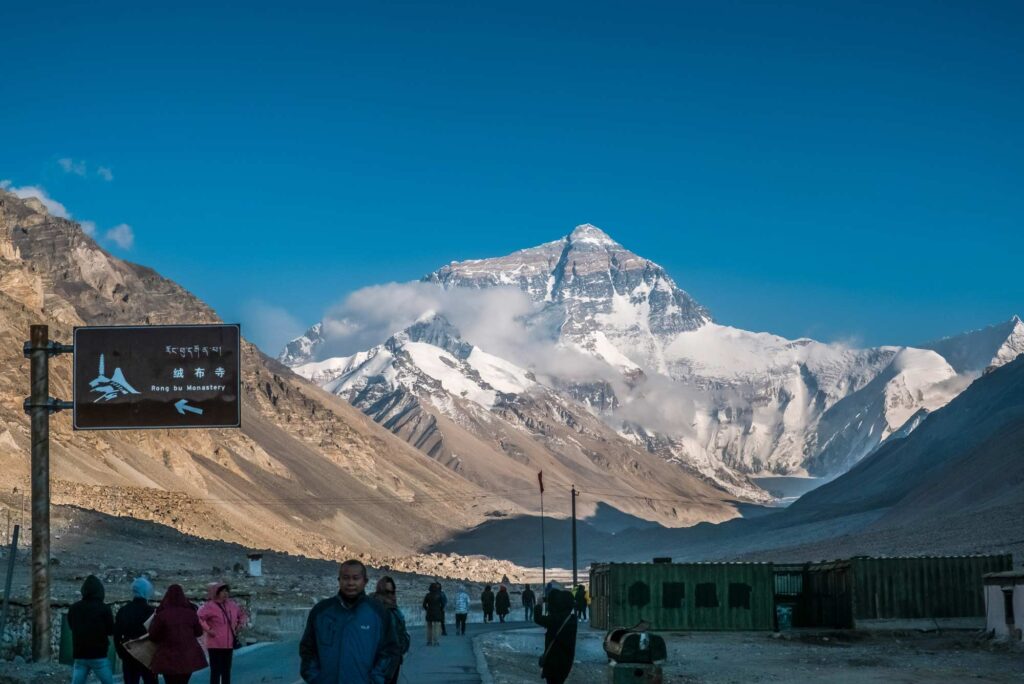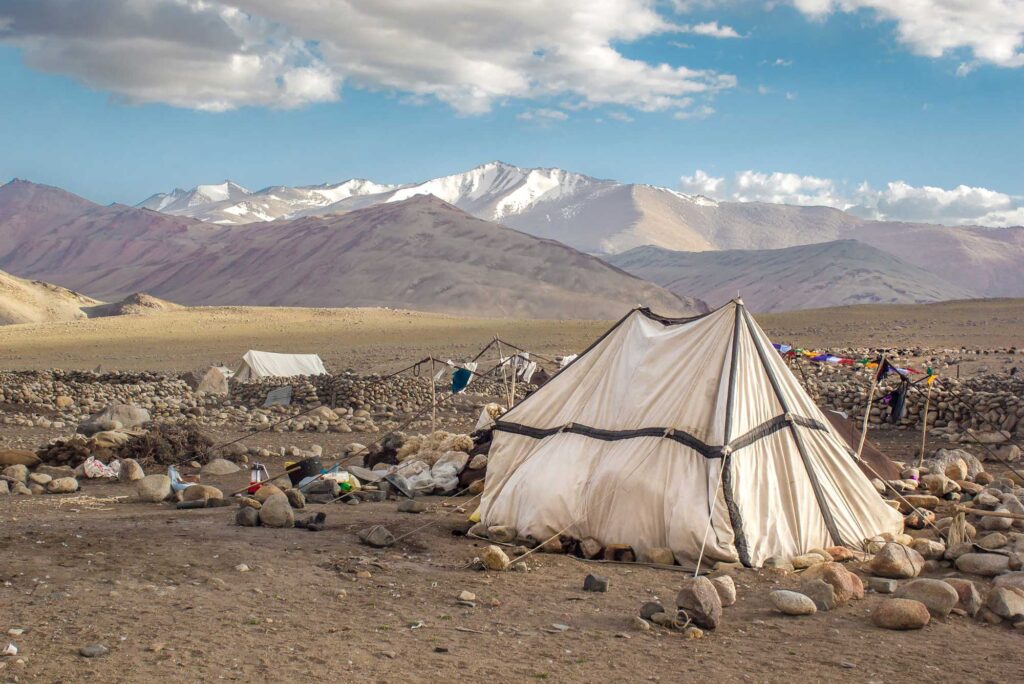Lhasa to Kashgar Overland Tour
The Lhasa to Kashgar Overland tour provides a unique opportunity to explore the vast wilderness of the Tibetan Plateau. During this journey, you will spend several days in Lhasa, where you’ll have the chance to visit cultural centers and monasteries, including the Potala Palace, Jokhang Temple, Norbulingka (the Summer Palace), Sera Monastery, and Drepung Monastery.
Following your time in Lhasa, you will embark on a drive along the Friendship Highway towards the Everest Base Camp. Along the way, you’ll get to experience the sights of Gyantse town, Shigatse city, Sakya Monastery, and finally reach the iconic Mount Everest base camp. This route will also take you to significant landmarks like Mt. Kailash and the Guge Kingdom.
At the Everest Base Camp, you’ll have the unique opportunity to spend a night in a tent guest house near Rongbuk Monastery. Afterward, you’ll continue your journey to Mt. Kailash, where a three-day trek around the Holy Mountain awaits you. The adventure then leads you to the Guge Kingdom, where you’ll explore the historical ruins of this ancient realm.
As the Lhasa to Kashgar Overland tour comes to an end, you’ll make your way to Kashgar by driving through the breathtaking Karakoram mountain range. This journey promises an unforgettable experience, allowing you to immerse yourself in the stunning landscapes and rich cultural heritage of Tibet.
Tour Itinerary of Lhasa to Kashgar Overland tour
Day 1: Arrival in Lhasa
Upon your arrival in Lhasa, our tour guide will greet you at either the train station or the airport and accompany you to your hotel. We suggest taking some time to rest in your hotel before heading out. This is important as your body needs to adapt to Tibet’s high altitude and lower oxygen levels. Depending on when you arrive, if you find yourself with free time, you can explore the Barkhor street near the Jokhang temple.
Day 2: Lhasa guided tour
In the morning, you’ll start by visiting the Jokhang Temple, which is considered the most sacred among all the Buddhist temples and monasteries in the Inner Himalaya region. This temple was established in the 7th century by Tibetan Buddhist King Songtsen Gampo to house the most revered statue of Lord Buddha. He acquired this statue as part of his marriage to Chinese Princess Wengchen. As you explore, you’ll witness thousands of pilgrims who come to the temple to walk around it, bow down in reverence, and experience its sanctity.
Moving on to the afternoon, your next stop will be the Sera Monastery. This monastery ranks among the three largest ones in Lhasa and central Tibet. It was founded around 600 years ago by the chief disciple of Je Tsongkhapa. A special highlight of your visit will be witnessing the monks engaging in debates about Tibetan Buddhist Philosophy. You can observe these lively debates in the courtyard starting from 3 pm on weekdays. It’s quite an interesting sight to watch and you’re welcome to take photographs, though only using your mobile phone while inside the courtyard.
Day 3: Lhasa guided tour
In the morning, the group plans to explore the Potala Palace, the most iconic structure in Tibet. With over 1000 rooms, it soars above Lhasa city. Originally constructed in the seventh century by King Songtsen Gampo, the palace was later reconstructed in the 17th century by the fifth Dalai Lama, who built his residence on the ruins of the old palace. Since then, the palace has functioned as the winter residence for successive Dalai Lamas and as the administrative center for the local Tibetan Government.
During the afternoon, the group will head to Drepung Monastery, one of the three largest monasteries in Lhasa and central Tibet. In the early 20th century, it held the distinction of being the world’s largest monastic complex. Taking about an hour to complete, the circuit around the monastery offers breathtaking views.
Day 4: Lhasa - Yamdrok Lake - Karola Glacier - Gyantse
Distance: 263km Drive: 6hr.
It is recommend starting your journey a bit earlier in the morning. In most cases, we depart from Lhasa at 7 AM after having breakfast at your hotel. By 11:00 AM, you will arrive at the Kampa-la pass, which sits at an altitude of 4700 meters. At this point, the car will pause, allowing you to take in the stunning view of Yamdrok Lake below the pass, as well as the majestic Mount Nojin Kangsang, which reaches a towering height of 7191 meters. After capturing some photographs and enjoying the scenery from the pass, we’ll make our way down to the lake. The drive to the lake takes about 15 minutes, during which we’ll descend around 700 meters to the shoreline. Here, we’ll take a break, giving you the opportunity to appreciate the beauty of the lake up close.
Following our time at the lake, we’ll continue our drive to Nangartse town, where we’ll have lunch. The journey from Yamdrok Lake to Nangartse covers a distance of 50 km, with the route running along the lake’s shoreline until we turn towards the town. If you’re traveling in winter, you’ll have the chance to spot a variety of wild birds along this road. For bird enthusiasts, it’s a good idea to bring binoculars. Upon reaching Nangartse town, we’ll halt for a satisfying lunch. Afterward, there’s an opportunity to explore this charming Tibetan town for a while.
Our journey then continues to Gyantse town. We’ll make a stop at the Karola Glacier, where you can spend some time. You should arrive in Gyantse town around 3:00 PM. Once there, we’ll check into our hotel for the night. After settling in, we’ll proceed to visit the Gyantse Palchoe monastery and the Kumbum Stupa. The Kumbum stupa, a magnificent Tibetan Buddhist structure, is particularly noteworthy. Exploring the monastery will take approximately one and a half hours. If you still have some energy left, we can also visit the Gyantse fort.
Day 5: Drive from Gyantse to Shigatse via Shula monastery
Distance: 95kms Drive: 2:30hrs
Your journey will begin around 9:00 am. As you leave Gyantse town, we’ll make a stop at a photography spot just outside the town. This spot offers a panoramic view of Gyantse town, including its monastery, stupa, and fort – a favorite picture-taking location of mine in Tibet.
Leaving Gyantse behind, our next destination will be Shalu Monastery. Many travel and tour operators in Tibet skip this site in their itineraries. However, I believe it’s a must-visit place. Inside the monastery, you’ll find unique paintings done in the original Newari style.
After exploring Shalu Monastery, our journey will continue to Shigatse. Upon reaching Shigatse, our first stop will be Tashi Lhunpo Monastery. This monastery was built by the first Dalai Lama and serves as the official residence of the Panchen Lama. Following our visit to the monastery, we’ll head to the hotel. The remainder of the day will be free time for you and the group members. However, please note that we’ll need to arrange for the permit to visit Everest Base Camp.
Day 6: Drive to new Tingri via Sakya monastery
Distance: 286kms Drive: 7hrs
Today, we’re kicking off our day a bit earlier to maximize our time at Sakya Monastery. Our journey will lead us along the Friendship Road. Departing from the Tibetan town of Lhatse, we’ll make a detour en route to Sakya Monastery. This monastery stands as the primary focal point of the Sakyapa school of Tibetan Buddhism. Its appearance mirrors that of a medieval fortress. The architecture and artwork of Sakya Monastery distinguish themselves significantly from any other site you’ll encounter on this tour. The monastery offers a plethora of sights to explore, prompting our early departure from Shigatse.
Following our visit to Sakya Monastery, we’ll press on towards Tingri, where we’ll spend the night before advancing to the Everest Base Camp.
Day 7: Drive to Everest Base Camp
Distance: 110kms Drive: 4hrs
If you want to witness the morning sunlight over the majestic Himalayas and Everest, you need to start your journey before the sun rises. We always advise travelers to set out before dawn to catch the breathtaking sunrise over Everest and its neighboring peaks. Before we reach the Rongbuk Monastery, we’ll switch to an Eco Electric bus for a more eco-friendly ride.
Once we arrive at the Rongbuk Monastery, we’ll take some time to rest at our comfortable Rongbuk Monastery Guesthouse before proceeding to the Everest Base Camp.
During our stay at EBC, we’ll spend the night either at the Rongbuk Monastery Guesthouse or in tented accommodations. It’s recommended to opt for the Rongbuk Monastery guesthouse, as the tents can sometimes get smoky. If you’re experiencing altitude-related concerns, there’s an option to return to Tingri. Please make a clear decision and inform us before everyone settles in for the night.
Day 8: Everest—Peiku Lake—Saga
Distance: 300kms Elevation: 4500m
Today, you have another opportunity to approach the majestic Everest. Wake up early and head there to witness the breathtaking sunrise over Everest. We will journey from Mt. Everest, passing by the Shishapangma, and our next destination will be the stunning alpine lake, Pei ku Tso. While driving to the lake, you’ll enjoy awe-inspiring views of Himalayan peaks towering over 7000 meters, along with the chance to spot wildlife. Once we’ve explored the lake, we’ll continue our drive to the town of Saga. In Saga, you’ll find our final quality hotel with assured hot running water. From this point onward, expect very basic accommodations and meals.
Day 9: Saga to Darchen
Distance 520kms, Elevation: 5000m
Get ready for an authentic adventure through the untamed Western Wilderness of Tibet! You’re about to embark on a journey that truly captures the essence of this mesmerizing region. Prepare to be awestruck by the breathtaking Tibetan Plateau landscape. Our route will trace along the majestic Yarlung Tsangpo river, covering a total distance of 520 kilometers of pure natural beauty.
A must-see on our itinerary is Manasarovar Lake, one of Tibet’s three most sacred lakes. According to Hindu beliefs, immersing yourself in the holy waters of this lake absolves you of sins accumulated over many lifetimes. Take time to meditate along the serene lakeshore, finding tranquility in this sacred setting. Following our peaceful pause at the lake, we’ll resume our drive towards Darchen, the pivotal starting point for trekking around Mount Kailash. Here, we’ll rest and make preparations for the adventures that await us tomorrow.
Day 10-12: Trekking around the Mount Kailash
Distance 54kms, Max Elevation: 5630m
The highlight of the tour is the three-day trek around Mt. Kailash. We will trek alongside the mountain for three days. Along the trekking route, you’ll find minimal accommodations and facilities. This high-elevation trek can be challenging, with steep sections in some areas. It’s important for group members to stick together and assist each other during the trek. As soon as you arrive in your room, it’s recommended to go to bed immediately. This will help you regain energy and preserve body heat.
On the first day of the trek, we’ll cover 20 kilometers from Darchen to Dira Puk Monastery, circling around Mt. Kailash. You’ll share this ancient pilgrimage route with Tibetan Buddhist and Indian Hindu pilgrims. Accommodation will be provided in a small guesthouse near the monastery. The elevation of Dira Puk Monastery is 5080 meters.
The second day of the Kailash trek will take us over the Dolma La Pass, the circuit’s highest point at 5630 meters. Throughout the day, you’ll enjoy impressive mountain and glacier views. Descending from the Dolma La Pass, we’ll reach Zutul Puk Monastery at an elevation of 4820 meters. The total distance covered this day is 18 kilometers.
The third and final day of the trek will encompass a 14-kilometer journey from Zutul Puk Monastery back to the town of Darchen. After completing the trek, we’ll return for a final night near the picturesque Lake Manasarovar. At Lake Manasarovar, you’ll find a mineral-rich hot spring that offers a great opportunity to relax and rejuvenate.
Day 13: Manasarovar Lake to Guge Kingdom
Distance 254kms, Max Elevation: 3699m
We’re going to drive for five hours from Manasarovar Lake to the Ruins of Guge Kingdom. The generation of Tibetan kings built this kingdom after escaping civil unrest in Lhasa, following the death of the Last King of Tibet in Tibetan History. The kingdom thrived for seven centuries as the central trading hub along the ancient silk route. However, the military campaign of Ladakh and the intervention of the 5th Dalai Lama’s administration in Lhasa led to the downfall of the Guge Kingdom’s glory. Our tour guide will share plenty of information about the Kingdom and its history.
During our trip, we’ll explore both Tholing Monastery and the ruins of the Kingdom. For the night, we’ll be staying at a local hotel with basic amenities.
Day 14: Guge Kingdom to Siquanhe
Distance: 255Kms Elevation: 4255m
First, we’ll explore the Tholing monastery in Zanda. The 2nd king of Guge Kingdom constructed this monastery in 996, and it holds a crucial role in revitalizing Tibetan Buddhism in Tibet. Once we finish our visit to the monastery, we’ll journey 255 kilometers to reach Siquanhe.
Day 15: Siquanhe to Rutog Via Pangong-tso Lake
Distance: 117Kms Elevation: 4260m
Today, we are going to Rutog, covering a distance of 117 kilometers. On our way, we’ll have the opportunity to explore the stunning Pangong-Tso Lake, known for its remarkable beauty. This lake boasts the world’s highest bird island, situated at a breathtaking elevation of 4240 meters above sea level. Once we’ve enjoyed our visit to Pangong-Tso Lake, we will proceed with our journey towards Rutog.
Day 16: Rutog – Domar - Dahonliutan
Distance: 518Kms Elevation: 4200m
Today, we are departing from the Tibet Autonomous Region and entering the Xinjiang Uyghur Autonomous Region. We will be driving 518 kilometers, passing through Jieshan Pass to reach Dahonliutan. This area is often referred to as the “Roof of the World.”
Day 17: Dahonliutan to Yecheng
Distance: 499Km, Elevation: 1375m
Today, we are departing from Dahonliutan and heading towards Yecheng. Our journey will take us over several high passes, including Heika Pass, Kudi Pass, and the Maza Pass. Along the route, we will be treated to magnificent views of the Kunlun Mountain range. We plan to spend the night in Yecheng.
Day 18: Yecheng to Kashgar
Distance: 285Kms Elevation: 1278m
We are going to journey from Yacheng to Kashgar. The distance is 285 kilometers, and we’ll pass through the breathtaking landscape of the Gobi Desert’s sand dunes.
Day 19: Exploration around Kashgar
Distance: 285Kms Elevation: 1278m
We’re going to explore the Apak Hoja Tomb (known as Xiangfei Mu in Chinese), where we’ll discover the intricate architecture of Uyghur Islamic traditions. Then, we’ll head to the bustling Popular Uyghur Bazaar, famous as Central Asia’s largest market.
After having lunch, we’ll continue our journey to the historic Kashgar old Town and the impressive Id Kah Mosque, which holds the title of China’s largest mosque.
Day 20: Departure from Kashgar
You will journey to your next destination, while your tour guide and driver will return to Lhasa.
Tour Services of Tibet Winter Cultural Excursion
Included
- All necessary Tibet travel permits.
- Entrance ticket for all the attractions listed in the itinerary.
- Entrance for your Vehicle and guide for the Everest Natural Reserve.
- Private transportation in Tibet with experienced local Tibetan driver: Ranging from Business van to minibus depending on the group size.
- English speaking Proffesional Tour guide (Local Tibetan).
- Lodging in three star rating hotels: Hotel rooms are based on double occupancy ( with Breakfast).
- Free shuttle Pick-up and send-off services at the beginning/end of the tour.
- A mobile with local SIM card during the tour with your tour guide (it can receive international calls and text messages).
- An Oxygen tank and First Aid box in Car (Size of Oxygen Tank base on group member).
- Two water bottle each day/person.
- Lodging and meals for guide and drivers.
Excluded
- Travel insurance which covers tour cancellation and emergency evacuation (highly recommended to buy from your home country).
- Chinese Visa or Tibet Group Visa ( If coming from Nepal).
- International and domestic flight/train tickets.
- Lunches and Dinners averagely a meal in Tibet (Around USD5 per person).
- Gratuities (Tips) for the guide and driver. ( Highly recommend to give at end of tour).
Tour Map



